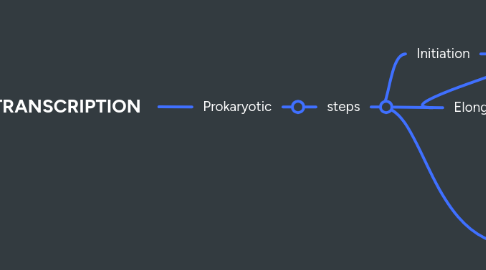
1. eukaryotic
1.1. types of polymerases
1.1.1. RNA polymerase I
1.1.1.1. located in the nucleolus
1.1.1.2. catalyzes the synthesis of 28S, 18S, and 5.8S rRNA molecules
1.1.2. RNA polymerase II
1.1.2.1. located in the nucleoplasm
1.1.2.2. synthesizes messenger RNAs and some small nuclear RNAs
1.1.3. RNA polymerase III
1.1.3.1. located in the nucleoplasm
1.1.3.2. synthesizes tRNAs, 5S rRNA, a small rRNA molecule found in each ribosome, and the snRNAs
2. Prokaryotic
2.1. steps
2.1.1. Initiation
2.1.1.1. Promoter
2.1.1.1.1. A sequence of DNA upstream of a gene which is to be encoded where RNA Polymerase binds to initiate Transcription.
2.1.1.1.2. Ensures initiation of transcription at the same site.
2.1.1.2. RNA chain synthesized in 3'-to-5' direction, with only one strand of the DNA as a template. No primer is required in the process.
2.1.1.3. DNA sequences critical for specifying the initiation of transcription
2.1.1.3.1. (the -35 box) 5’-TTGACA-3’.
2.1.1.3.2. (the -10) 5’-TATAAT-3’.
2.1.1.4. One type of RNA polymerase
2.1.1.4.1. holoenzyme
2.1.1.4.2. sigma factor
2.1.1.5. Process:
2.1.1.5.1. The holoenzyme contacts the -35 sequence.
2.1.2. Elongation
2.1.2.1. The RNA polymerase begins to move along the DNA
2.1.2.2. The sigma factor is released
2.1.2.3. Process:
2.1.2.3.1. RNA polymerase becomes more compact, contacting less of the DNA.
2.1.3. Termination
2.1.3.1. The termination of bacterial gene transcription is signaled by terminator sequences
2.1.3.2. Process:
2.1.3.2.1. The RNA polymerase transcribes the terminator sequence which is part of the initial RNA coding sequence of the gene
2.1.3.2.2. the inverted repeat arrangement makes the RNA fold into a hairpin loop structure
2.1.3.2.3. string of U nucleotides downstream of the hairpin destabilizes the pairing between the new RNA chain and the DNA template strand causing RNA polymerase to dissociate from template strand
